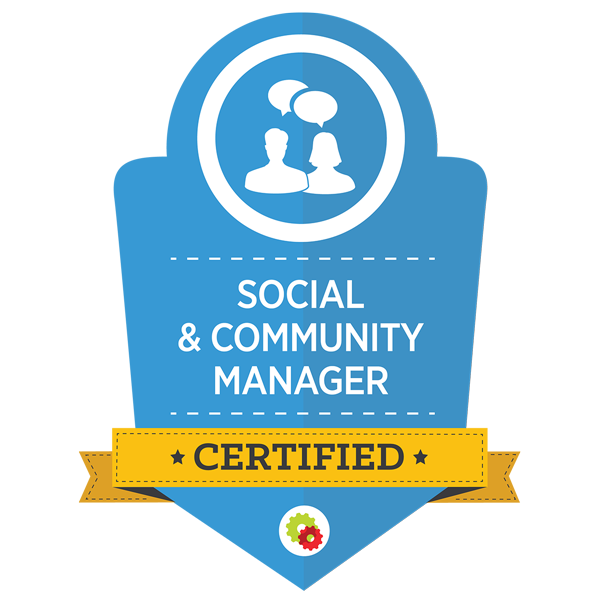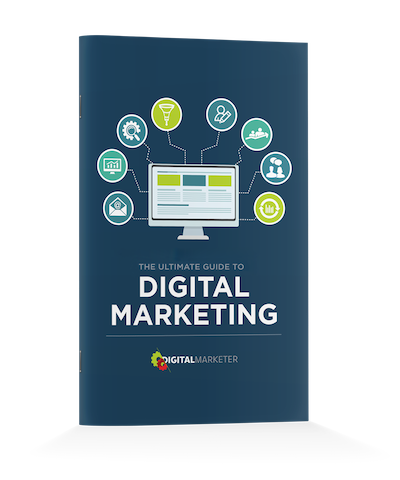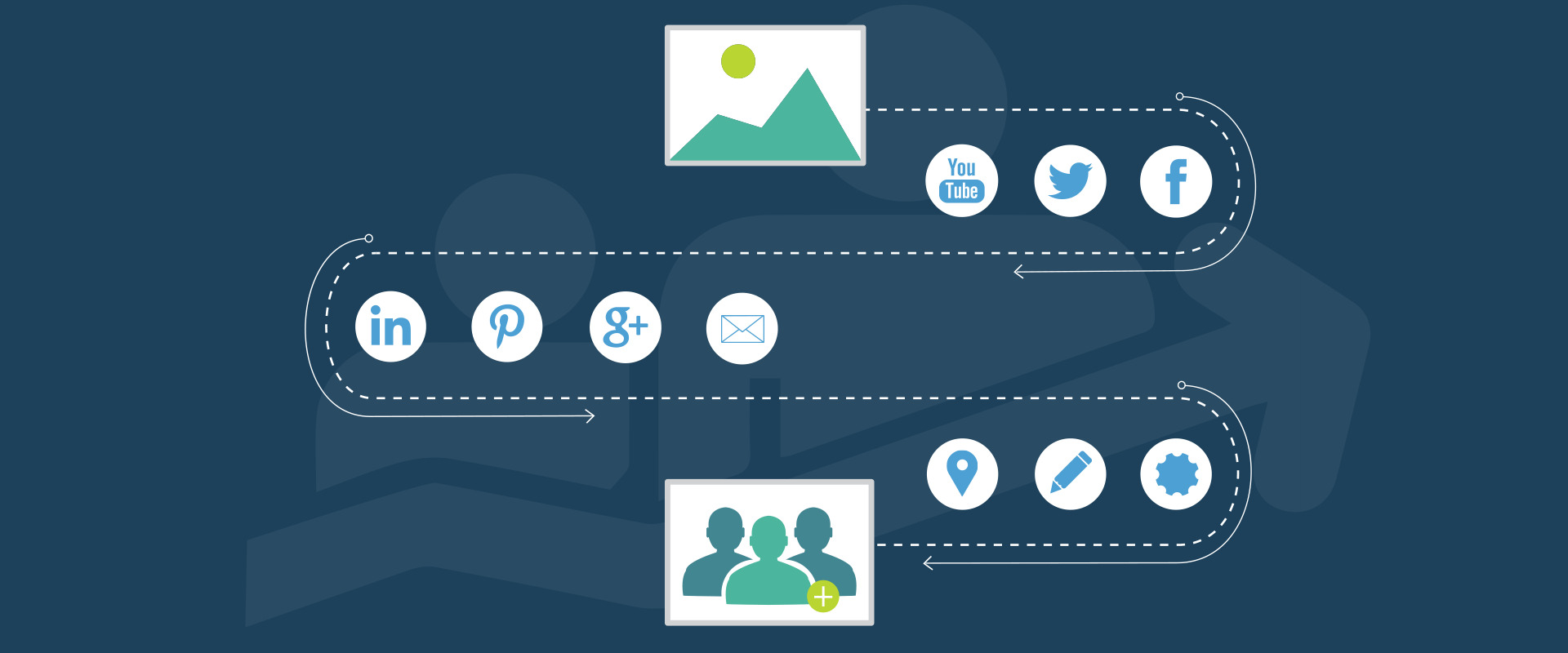CHAPTER
04
Developing a Social Media Strategy
If marketing is about putting your message where your audience hangs out (which it is), then social media is a no brainer.
That said, many businesses fail to fully leverage social media in their marketing plans. They dabble, sure, but their strategic efforts end with content and advertising.
That's a big mistake, and here's why...
Today, 79% of US internet users are on Facebook. Six out of ten Americans stay updated on news through social media, while 35% have used social media to look for or research a job.
And these same numbers are reflected worldwide. Is it any wonder marketers are going social to grow their business?

The trouble is that "going social" isn't as easy as it looks. There’s a lot more to social media marketing than simply posting to Facebook and Twitter.
In this chapter, we cover the basics of a successful social media program, including methods and metrics, the business roles that should own your social media marketing, and the lingo you’ll use to talk about it.
Keep in mind, there’s a big difference between a social media manager and a community manager. (Yes, both manage social media efforts, but their focus is different.) Learn more in our article, Social Media Manager vs. Community Manager.
Methods of Well-Executed Social Media Marketing
There are 4 stages in a successful social cycle:
- Listening
- Influencing
- Networking
- Selling

The social success cycle has 4 stages, beginning with listening.
All 4 of these stages are key to reaching social media success. But all of it hinges on Stage 1: Social Listening.
Listening gives you the insights you need to perform the other 3 stages well. It helps you develop a strategy that will give you influence, a strong network, and lots of leads and sales.
The key, of course, is to get your information in front of your prospects and customers where they hang out online. For most businesses, that includes one or more of these top social networking sites.

If you’re worried about the time drain that social media can be, don’t worry. Social media marketing isn’t about hanging out with your prospects and customers. It’s about executing the social cycle while minimizing costs—which means you need to master the methods and metrics for all 4 of the stages.
1. Social Listening
As with any marketing strategy, you need to start with your target audience. That’s why social media marketing starts with listening.
This is key to creating a successful social strategy.
Whether you’re paying attention or not, people are talking about you and reaching out to you on the social web. They’re sharing their experiences with your products. They’re talking about the things you’re saying or doing. They’re even asking you questions.

Whether you're paying attention or not, people are talking about you on the social web.
Some comments, like these, are positive. You’ll want to celebrate them—and respond with a great big thank-you.

Negative comments need immediate attention.
Other comments aren’t so positive (and some are downright negative). They need immediate attention so followers know you’re present and accessible.
It’s a lot like customer support. And in the same way, it can help or hurt your public perception.
Every day, your social phone is ringing.
If you don’t answer, it leaves a bad impression. On the social web, it’s a bit like leaving your customer service lines unattended.
But when you do answer the call, listening and responding appropriately, you can connect with your fans and followers, find and fix issues you may not be aware of, and build incredible good will.
The key, of course, is to make listening your #1 priority and use your insights to inform the other 3 stages of the social success cycle.
Goals of Social Listening
What are you listening for? When tuning in to social conversations, your goals are to:
- Track public perception of your brand.
- Identify the topics you need to be talking about.
- Keep a pulse on the industry, where it’s going, how it’s being perceived.
- Perform customer research.
- Conduct competitive research.

When social listening, you’re tuning into 5 key bits of information.
In particular, pay attention to these 5 things:
- Your brand – Watch for mentions of your company name, your products, or any other identifying information.
Example: Apple might watch for mentions of the Apple watch or anything related to iOS. - Topics relevant to your industry – You want to stay on top of the pulse of your industry. So listen to the topics people are bringing up, their questions, and their hot buttons.
Example: Apple might follow conversations around wearable tech or smartphone cameras. - Your competitors – What’s being said about them? Is it positive or negative? And what are your competitors saying about you?
Example: Apple’s competitors might be Android or Jeff Bezos. They’d be wise to watch for mentions of them. - Influencers – Listen for the topics thought leaders and influencers are talking about, and look at the content they’re producing. They’re all clues for where the industry is moving.
Example: Apple should probably keep an eye on GigaONE and John Gruber. - Public facing people in your company – Watch for mentions of your leaders and influencers. What’s being said? Is it positive or negative?
Example: Mentions of Tim Cook and Arthur Levinson can reveal public perception of the Apple brand.
Your aim is to tune into the pulse of public sentiment towards your brand, your industry, and the topics that relate to your brand. In a sense, it’s reputation management. But it can also help you perform real-time customer service and identify product or content gaps that need to be filled.
Putting Your Listening to Work
Listening is only half of the equation. You also need to respond to the things you see and hear.
A strategic "feedback loop" is the best way to do this.
What is a feedback loop? It’s a process you create for your teams to use when addressing issues that arise during social listening. It clearly maps out the people or departments that issues should be routed to and who has responsibility for resolving them.
Here’s how it works...

You put a social media manager (or team member) in place, actively listening.
When your social listener sees a complaint or issue, say in Twitter, they'll perform "triage"—responding with an empathetic "you've been heard" response—and then route the issue to the proper team. This happens within 12 hours of the complaint/issue.
Once the issue has been forwarded to the appropriate person, this specialist will then respond to the issue, aiming to resolve it completely within 24 hours.
Here’s why it works...
Having a social media listener is well and good, but in the real world, they often don’t have the specialized knowledge or authority to resolve the issues that will arise. And sometimes they don’t know who should take care of those issues, either.
That’s how issues get overlooked and forgotten, resulting in untold damage to your brand.
But with your feedback loop, that won’t happen. This flowchart clearly maps out the most appropriate departments for resolving different issues. For example:
- Who in Customer Care will handle customer service issues.
- Who on the Content team will handle content issues.
- Who on the Product team will handle product issues.
So your social listener knows exactly who to alert when issues arise, and your social media team is able to quickly respond to anything they see.
Let’s break this down into 3 basic steps.
The 3-Step Social Customer Service Plan
For social media marketing to work, you need to make it human and authentic. Even when you’re dealing with a complaint, your aim is to align yourself with the person, de-escalate the situation, and provide a compassionate, human touch.
Here’s the 3-step process for doing that:
- Respond quickly. Social media moves quickly. Make sure you perform triage within 12 hours and resolve issues within 24 hours.
- Empathize. Make an empathetic statement as soon as possible: "I'm sorry you ran into this," "I know this is frustrating," or "I can understand how important this is to you."
- Move it to a private channel. If you can’t solve the issue in a sentence or two, take it off public channels. Private messaging, email, or a phone call allow you to talk in detail without the rest of your followers adding their two cents to the discussion.
This approach demonstrates that you’re listening. It also allows you to express compassion. And by moving the conversation to a private channel, you make people feel as if you’re committed to giving them a real solution.
Metrics to Watch
What should you measure to track your social listening efforts?
- Reputation score (AKA sentiment level). Are people happy or sad when talking about you? Is the tone negative or positive?
- Retention rate. Are you retaining customers (and followers)? If not, why?
- Refund rate. Are you able to resolve issues without having to issue refunds?
- Product gaps identified. What suggestions are people making for new product features?
- Content gaps identified. What content should you develop to answer questions and resolve issues before they arise?
EXTRA: Read more about social listening and Feedback Loops here: https://www.digitalmarketer.com/social-listening/
2. Social Influencing
At this stage, your aim is to lead and direct your followers’ opinions, attitudes, and behaviors. And since you’ve been listening, it’s relatively easy. You already know the trending topics and conversations taking place, so adding your authority voice is the natural next step.
What are the signs that your influence is growing?
- You get more engagement – people retweeting or sharing your posts, and people responding to your posts.
- Your traffic numbers increase – people click on your links.
- You develop a greater mindshare – people share their questions, thoughts, and opinions with you, and they eagerly seek interaction with you.
- You become a recognized authority and a brand people watch.
Keep in mind, this stage of the success cycle is influenced by the social listening you did in Stage 1. But the reality is that you’ll continue listening at every stage. In fact, once the cycle is going, you’ll perform every stage every day.
Goals for Social Influencing
During this phase of the social success cycle, you’re trying to:
- Increase engagement with your brand and your content.
- Start conversations around the topics related to your business.
- Boost traffic to your site.
- Build awareness of your products and offers.
- Grow your retargeting list.
Retargeting is an advanced tactic that can significantly boost your bottom line. To learn more about retargeting (or remarketing), read The Remarketing Grid: The Science of Ad Retargeting Audience Segmentation.
Metrics to Watch
How do you know you’re building your social influence? These are the metrics that matter most:
- Site engagement rates. Are you getting more social shares and comments?
- Traffic by channel. Traffic from your social media channels should increase over time.
- Offer awareness. People see and respond to the offers you make in social media.
- Retargeting list growth. Through retargeting, you’re able to get your offers in front of people who are most likely to buy from you—and they respond by downloading your lead magnets and subscribing.
Need help boosting traffic from social media? The key is to leverage your blog posts in social channels. This post gives you a 6-step process for socializing a blog post.
3. Social Networking
It’s at this stage of the social cycle that you connect with other influencers and authorities and begin to move the needle.
Social networking is important for all businesses, whether you’re just getting started, scaling, or expanding into new markets.
It may help to think of social networking as a live event—except your interactions are online rather than face-to-face. After all, networking is networking, no matter where (or how) it happens. And it can lead to deep and lasting relationships, both with your followers and potential partners.
The Process of Social Networking
Each time you publish an article on your blog, produce a new piece of content, or have a new offer, you’ll create social media posts designed for the channels you’re posting to (think “native” content) that get the word out.
You’ll share valuable content from peers and, yes, even your competitors. If it relates to your brand’s primary topic and helps your followers, it’s worth sharing. You’ll also engage with people one-on-one, both asking and answering questions.
That’s it.
Now let’s look at this process in action.
Here’s one of our own articles, which we shared in Facebook and Twitter. Notice that each post is appropriate for the channel.

We also post conversational posts, like this one from our Twitter stream:

Conversational Twitter posts
But we also want to share content that would help beginning digital marketers. After all, they may someday become our customers. So we share back-to-basics content and useful information from other brands.
Take these, for example:

This post from ThinkwithGoogle aligns with our values.

Email marketing is one of the core competencies we teach, so this post from MailChimp is a good fit.
By adopting a similar approach, you won’t just attract happy followers, though you’ll have plenty of those. By sharing useful content from other brands, you’ll build good will and strong alliances with the brands you share.
For example, we’ve consistently shared content from Content Marketing Institute, Buffer, and MarketingProfs. Initially, that led to a robust network. But some of those relationships have turned into strong partnerships, as well.
Your Goals for Social Networking
During this stage of the social success cycle, your aim is to:
- Share content that fills gaps left from your own content. This content may relate topically or target people at different skill levels.
- Create good will with brands that are similar to yours.
- Over time, transform that good will into profitable partnerships.
Metrics to Watch
To measure the strength of your social network, watch these metric:
- Number of inbound links. A strong network will result in more backlinks to your content.
- Number and description of earned media mentions. Consider the relevance and value of the mentions, who they come from, and the value of those mentions.
- Number and description of earned strategic partnerships. Are you reaching out to partnership prospects, or are they reaching out to you? How relevant are those brands to your business, and what is the value of those relationships?
Getting more clicks from social media requires irresistible headlines. Steal from this headline swipe file.
4. Social Selling
The fourth and final stage of the social success cycle is social selling.
This is where social media marketing gets interesting. Finally, after listening to your prospects, building authority in your space, and establishing a strong network, you can start putting your offers in front of people—and converting them.
What does good social selling look like?

Good social selling integrates with your funnels
The short answer is funnels. But you’ll use multiple channels for getting people into those funnels, from blogging to retargeting to pay-per-click advertising.
So, for instance, you’ll lead with blog content that’s perfectly targeted to your audience, and in that content, you’ll embed an opt-in offer. Then you’ll promote the content in social media (leveraging Stages 2 and 3 of this cycle).
Your social promotion will direct traffic to your content, where they’ll see your offer. If they respond, you’ll immediately make an upsell offer—a low-priced product designed to convert your new lead quickly into a customer. We call that entry-level product a tripwire.
But what if a visitor doesn’t respond to your offer?
You’ll retarget them with a relevant ad, so they receive multiple touches that could lead to a conversion after they leave your site. The ad takes them to a funnel, where they’re offered the same (or a related) lead magnet—and then an entry-level product.
Of course, you should also try to upsell and cross-sell to existing customers.

Upsell and cross-sell to existing customers.
For example, if they buy a patio cover, they’re probably in the market for patio furniture. Retarget them with the next logical offer.
The point is this: Don’t simply create one offer. Create a buying path that boosts the lifetime value of every customer.
Goals for Social Selling
Your goals at this stage are to:
- Generate leads to grow your email list.
- Acquire new customers and upsell/cross-sell existing customers.
- Increase buyer frequency, turning one-time customers into raving fans.
Metrics to Watch
To track your success at social selling, watch these metrics:
- Number of leads. Over time, your email list show grow.
- Offer conversion rate. Are your offers converting? Maybe your offer isn’t relevant or isn’t close enough to your prospects’ bottom-line desire.
- Buyer recency / frequency. You want customers to buy repeatedly and often.
We’ve covered the metrics you should watch for each stage of the social cycle, but maybe you’d like more information. For a deep dive into metrics and social ROI, read 7 Ways to Actually Track Social Media ROI.
Relevant Roles in Social Media Marketing
Once you understand the basics of social media marketing, you need to identify the people who will be responsible for managing your success.
There’s no right answer. It will depend on your organization and goals. But in most cases, you’ll find your best solution in one of three departments.

Marketing
Marketing and social media integrate so closely, it’s hard to tell where one ends and the other begins. And most marketers are already involved in social media since it gives them the 3 things they need to do their job well:
- Customer insights.
- Understanding of the trends and conversations influencing their prospects.
- A powerful channel for disrupting the status quo.
Because they’re already actively participating in social media, marketing professionals could be a good fit for managing/directing your social media efforts.
Sales
Like marketing, successful sales depends on being relevant and current. Salespeople often use social media to engage with prospects, identify talking points, and figure out what matters most to people evaluating their products.
That being the case, someone on your sales team may be a good fit for managing/directing your social media program.
Public Relations
Public relations is another good option for taking responsibility of your social media. PR is all about creating a positive brand perception, and it’s already customer centric, which makes it social by default.
Community Manager
One last source to consider is your community manager, if you have one.
Social media is about being present and truly engaging with your fans and followers. That’s pretty much the definition of a community manager.
If you already have an active social community, your community manager could be a good fit for taking on your social media efforts. They already create, maintain, and encourage member-to-member relationships. As your social media manager/director, they’ll simply scale those efforts.
The Lingo You’ll Use in Your Social Cycle
Knowing the lingo will help you communicate what you’re doing with other professionals. Here are 5 terms you need to know.
"Value First" Offer
Social media marketing is really just another channel for your marketing, which means you’re creating an environment where you can make successful offers.
Offers that are appropriate for social channels include:
- Valuable content. Link to content that has embedded offers and CTAs.
- Lead magnets, or opt-in offers. These are designed to get cold traffic into your funnels.
- Tripwires, or deep-discount offers. Use these to upsell and cross-sell new and existing customers.
Feedback Loop
You need a system where complaints, praise, and other useful comments “heard” during social listening are routed to the correct person in your organization.
This makes it easy to apply the 3-step social customer service plan:
- Acknowledge the concerns.
- Forward the issue to the right person.
- Take the issue off public channels and resolve it in a timely manner.
Social Media Bouncing
Much of the success of social media marketing is the frequency of "touches." If you’re on more than one social channel, and people see you on multiple channels, you create a j-curve of exposure.
That’s what we call social media bouncing: A social media follower on one channel is exposed to your brand on another channel.
Take Taco Bell, for example.
First, you see them on a billboard.
Here at @tacobell we appreciate naked chicks! pic.twitter.com/Axs45jIvAa
— Jr.🌹 (@JaredRowland1) May 12, 2017
Then you follow them on Twitter.

Then you click through to their site or a Buzzfeed post where you see them yet again.

Your goal is the same—to engage with your followers on all your channels, fully immersing them in your brand.
Social Media Topic Map
Two keys to successful marketing are relevance and focus. Your topic map helps you stay "on brand" with both. As a bonus, by narrowing the topics you post about, you actually increase engagement.
Here’s how it works...
Take your brand, the products/services you offer, and your primary message. Then figure out the topics and subject matter that are "on brand" to discuss on social channels.
For example, for a health insurance company, the topic map would include the primary topic, insurance. But it could also include financial management and health.
Read more about topic maps here. https://www.digitalmarketer.com/increase-social-media-engagement/
Long-tail Media Outreach
This is the process of earning mentions from lots of small media players (bloggers, podcasters, etc.) instead of a small number of large media players.
You see, traffic may surge after a mention by a large-media player, but it will soon return to normal. Smaller media channels, on the other hand, have a more targeted audience that’s a better fit—and their audiences actually listen to them.
As a result, a few mentions from these smaller players can give you higher quality leads that actually convert. You may not get traffic surges, but your bottom line will get a boost.
The strategy? Figure out who the influencers are in your space, who’s listening to them, and whether they’re competitors or potential partners. Then build relationship with the small players who are a good fit for targeted outreach.
Your Social Media Success Metrics
We’ve talked about specific metrics for tracking the 4 stages of your social cycle, but there are a few more metrics that can show you whether you’re nailing your social media strategy overall. Here are 3 you need to watch.
Applause Rate
Every social share and mention is a form of applause. Because let’s face it, no one shares something they don’t perceive as valuable.
Measure the sum total of all social shares (Facebook, Likes, Tweets, LinkedIn shares, etc.) and comments on a piece of content.
Traffic by Channel
It’s important to know where your traffic is coming from. So use a tool like BuzzSumo that can measure your social traffic by channel.
Lots of engagement indicates you’ve found a topic your audience resonates with. Low engagement tells you you’ve missed the mark.

Ideally, you want to know who likes your content and how often it’s being shared. From that, you can figure out what’s working and where you need to improve.
Conversions from Social Media
Once you know the traffic that’s coming from social channels, the next step is to calculate your conversions from social media.
You want to know the percentage of visits from social media that take the action you’re driving on a web page. For that, the formula is:
[traffic from social media] divided by [total traffic]
Ultimately, this is the number you want to impact. The higher your conversion rate, the more successful your social media marketing is.
Bottom Line
Like it or not, we live in a social world. Your customers are on the social web, sharing experiences and opinions related to you, your brand, and your industry.
Are you listening?
The approach we’ve shared in this chapter will help you create a strategic social media plan that helps you keep up with the conversations taking place online, as well as getting you in front of your customers—and helping you lead, engage with, and sell to them.
But there's another (more direct) way for you to have conversations with your prospects and customers: email. And it's a vital piece of your digital marketing strategy.
Email is hands-down the most effective way to move prospects through the Customer Journey. It's also your ticket to loyal customers and repeat sales. So don't miss it.
Become a Social & Community Manager Specialist
Thanks to an ever-changing social landscape, consumers have altered the way they voice criticism and praise, the way they consume information, and, most importantly, the way they buy.
Successful brands must learn to adapt to these changes, and put plans and processes in place to listen, influence, network and sell in this environment.
In this mastery course, you’ll learn to assess business goals and employ sound social media marketing practices to meet those goals.
You’ll also be trained on the most up-to-date social media marketing practices that work TODAY, and will continue to work TOMORROW










